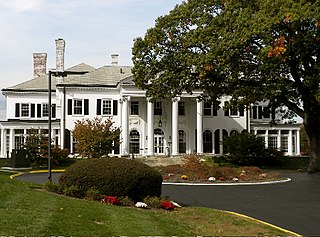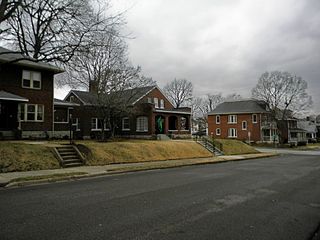
The Prospect Hill Historic District is an irregularly-shaped 185-acre (75 ha) historic district in New Haven, Connecticut. The district encompasses most of the residential portion of the Prospect Hill neighborhood.

There are 75 properties listed on the National Register of Historic Places in Albany, New York, United States. Six are additionally designated as National Historic Landmarks (NHLs), the most of any city in the state after New York City. Another 14 are historic districts, for which 20 of the listings are also contributing properties. Two properties, both buildings, that had been listed in the past but have since been demolished have been delisted; one building that is also no longer extant remains listed.

The St. Charles Historic District is a national historic district located at St. Charles, St. Charles County, Missouri. It is the site of the first permanent European settlement on the Missouri River and of the embarkation of Lewis and Clark's journey of exploration along the Missouri. The first state capital of Missouri and over one hundred other historic buildings are located in the district.

Hamlet of Warrensburgh Historic District is a national historic district located at Warrensburg, Warren County, New York. It includes 351 contributing buildings, three contributing sites, and five contributing structures. It encompasses the historic commercial core on the north side of the Schroon River and historic industrial core on the south side of the river of the hamlet of Warrensburgh. It includes more high styled residences and notable civic and religious properties on the north side and vernacular residences on the south side. Notable commercial buildings include the Woodward Block, Wills Block, bank building at 138 Main Street, and the former Sturdevan's Bakery. Three historic churches within the district are the Church of the Holy Cross (1864), First Methodist Church (1904), and United Presbyterian Church (1840). Civic buildings located within the district are the Richards Library (1900) and Warrensburgh Central School (1942). In addition, the Floyd Bennett Park and Bandstand (1930–31), named for Warrensburg native Floyd Bennett, is within the district.
The Adams Street Historic District in Franklin, Tennessee consists of properties at 1112-1400 Adams, 1251-1327 Adams St., and 304-308 Stewart St. It is a 14-acre (5.7 ha) historic district was listed on the National Register of Historic Places in 2000 and is one of seven local historic districts in the city of Franklin.

The 27th Street Historic District is a historic district in the South Los Angeles area of Los Angeles, California. The district was listed on the National Register of Historic Places in 2009 as part of the multiple property submission for African Americans in Los Angeles.

Wheeling Historic District, also known as the Wheeling Central Business District, is a national historic district located at Wheeling, Ohio County, West Virginia. The district includes 205 contributing buildings in the central business district of Wheeling. It includes the site of the original location of Fort Henry. The buildings are representative of a number of popular architectural styles from the early-19th century through the present including Greek Revival and Late Victorian. The District was listed on the National Register of Historic Places in 1979.

Edgefield Historic District is a national historic district located at Edgefield, Edgefield County, South Carolina. The district encompasses 33 contributing buildings, 6 contributing sites, and 1 contributing object in the town of Edgefield. The buildings center on the landscaped village green, and includes forty 19th century buildings, three of which are house museums. There are a number of 19th century Greek Revival style homes, while others are noted for beautiful Federal style fanlights and unusual doorways. Other district properties include Victorian influenced homes and downtown commercial buildings. Five churches represent the Georgian, Victorian Gothic, and modified Gothic architectural styles. Notable buildings include the Edgefield County Courthouse, Trinity Episcopal Church and Rectory, St. Mary's Catholic Church, Halcyon Grove, Oakley Park, Carroll Hill, Blocker House, Yarborough House, and Padgett House.

The Livingston Avenue Historic District is a historic district located along Livingston Avenue between Hale and Morris Streets in New Brunswick, Middlesex County, New Jersey. The district was added to the National Register of Historic Places on February 16, 1996, for its significance in architecture, social history, and urban history from 1870 to 1929. It has 58 contributing buildings and 2 contributing sites, including the Willow Grove Cemetery, the Henry Guest House, and the New Brunswick Free Public Library.

Hall Street Historic District is a national historic district located at St. Joseph, Missouri. The district encompasses 43 contributing buildings in a predominantly residential section of St. Joseph. It developed between about 1870 and 1920, and includes representative examples of Italianate and Late Victorian style architecture. Notable buildings include the Karl Schatz House, Rolanda Court Apartments, Chase-McClain House (1870s), John Forest Martie House, Oak Ridge Apartments (1890), James H. Robinson - William W. Wheeler House (1883), Cummings Ogden House (1885), Bill Osgood House (1890), and Missouri Methodist Hospital - Huggins House (1908).
Cynthia–Kinzer Historic District is a national historic district located around Cynthia and Kinzer Streets, Poplar Bluff, Missouri. It encompasses 55 contributing buildings 1 contributing site, and 17 contributing structures in a predominantly residential section of Poplar Bluff. The district developed between about 1907 and 1961, and includes representative examples of Colonial Revival, Tudor Revival, Bungalow / American Craftsman, and International style architecture. Located in the district are the separately listed Alfred W. Greer House and J. Herbert Moore House. Other notable buildings include the Fred Anderson House, Hubert C. Roland House, Lyle Kutchback House, Lawrence and Alma Tedrick House, C.P. Schultz House, J. Truman and Lena Carter House, Carl Capps House, and James and Nelda McPheeters House.
Historic District E is a national historic district located at Boonville, Cooper County, Missouri. It encompasses 88 contributing buildings in a predominantly residential section of Boonville. The district includes representative examples of Late Victorian style architecture. Notable buildings include the Dyer Residence (1870), Burns Residence, Rennison Residence (1890s), Lauer Residence (1830-1833), Robinson Residence (1905), Bell Residence (1886), Schuster Residence (1833), Kempf Residence (1890s), Cooper County Court Property, Morgan Street Baptist Church (1884), Waible Residence (1833-1848), and United Church of Christ.

Locust Street Historic District is a national historic district located at Washington, Franklin County, Missouri. The district encompasses 123 contributing buildings in a predominantly residential section of Washington. The district developed between about 1839 and 1949, and includes representative examples of Italianate, Queen Anne, Colonial Revival, and Bungalow / American Craftsman style residential architecture. Located in the district is the separately listed Franz Schwarzer House. Other notable buildings include the Lucinda Owens House (1839), Frederich Griese House, Sophia Greiwe House, Presbyterian Church (1916), Hy. Oberhaus House, Gustav Richert Apartment Building, Southern Presbyterian Church/Attucks School (1868), Washington High School (1887), and AME Church

Courthouse Square Historic District is a national historic district located at West Plains, Howell County, Missouri. The district encompasses 46 contributing buildings in the central business district of West Plains. It developed between about 1881 and 1950 and includes representative examples of Italianate, Queen Anne, Romanesque Revival, Late Gothic Revival, and Art Deco style architecture. Located in the district are the separately listed Elledge Arcade Buildings, W. J. and Ed Smith Building, and West Plains Bank Building. Other notable buildings include the IOOF Building #2, First Presbyterian Church, Howell County Courthouse (1937), Aid Hardware Building (1914-1915), W. N. Evans Building, J. R. Foster Building, Foster-Renfrew Building, Alsup, Risley & Skillman Block, Catron Opera House / Johnson Opera House (1893), IOOF Building / J. R. Galloway Building (1896), Evans Theatre, W. J. Zorn Building, #1/Howell County Gazette Building (1911-1912), West Plains Fire Department/City Hall (1917), and Avenue Theatre (1950).
Lewis and Sophie Griebel House is a historic home located at Warrensburg, Johnson County, Missouri. It was built about 1885, and is a one-story, cruciform-shaped, Folk Victorian frame dwelling. It has a steeply-pitched cross-gabled roof and ornate porches with flat roofs fill the spaces between the wings. The house features two types of imbricated shingles, lacy vergeboards with spindles, turned porch supports, serrated brackets, and a three-sided oriel window with elaborated panels. Also on the property are the contributing garage and chicken house.
John A. Adams Farmstead Historic District, also known as Cedarcroft Farm, is a historic home and farm and national historic district located near Warrensburg, Johnson County, Missouri. The district consists of four contributing properties—three contributing buildings and one contributing structure. The buildings are a house, a barn, and a barn. The structure is a system of sewer and drainage tiles and dams constructed beginning in 1875 and which underlays much of the district.

Downtown Troy Historic District is a national historic district located at Troy, Lincoln County, Missouri. The district encompasses 39 contributing buildings, 1 contributing site, and 2 contributing structures in the central business district and surrounding residential area of Troy. It developed between about 1832 and 1966, and includes representative examples of Late Victorian style architecture. Notable buildings include the Sherman Cottle House (1832), St. Stephens Methodist Church (1900-1901), Lincoln County Jail/Jailer's House (1876), Sacred Heart Catholic Church (1954), Lincoln County Courthouse (1869-1870), Troy Post Office, Farmers & Merchants Bank / Masonic Lodge (1906), Universalist Church / Masonic Hall (1837/1851), Lincoln County Motor Co. (1929), and United Baptist Church (1937).

Courthouse Square Historic District is a national historic district located at Chillicothe, Livingston County, Missouri. The district encompasses 24 contributing buildings in the central business district and surrounding residential area of Chillicothe. It developed between about 1877 and 1950, and includes representative examples of Late Victorian and Beaux Arts style architecture. Notable buildings include the Livingston County Courthouse (1914), Wallbrunn Building, First National Bank Building #2 (1906), Peoples Trust Building, Nick J. Rensch Building, Davis/Milbank Building, Leeper Hotel, Chillicothe City Hall (1926), First National Bank Building #1 (1887), and Sipple Clothing Co/Broyles Land Co Building.

Midtown Neighborhood Historic District is a national historic district located at St. Charles, St. Charles County, Missouri. The district encompasses 527 contributing buildings, 7 contributing sites, and 5 contributing objects in a predominantly residential section of St. Charles. It developed between about 1838 and 1959, and includes representative examples of Federal, Greek Revival, Gothic Revival, Italianate, Queen Anne, Romanesque Revival, Folk Victorian, Colonial Revival, Classical Revival, Tudor Revival, and Bungalow / American Craftsman style architecture. Located in the district are the separately listed African Church and Oliver L. and Catherine Link House. Other notable buildings include the St. Charles County Courthouse, Benton School (1896), St. John's A.M.E. Church (1872), Immanuel Lutheran Church (1867), Jefferson Street Presbyterian Church, Fourth Street Market Grocery (1926-1927), West End Grocery and Meat Market, Dr. Ludwell Powell House (1838), Rogers-Ehrhard House, Waye Monument Company and Residence (1889), Meyer House, Kaemmerlen House, and Elsner House.

The Polk County Homestead and Trust Company Addition Historic District is a nationally recognized historic district located in Des Moines, Iowa, United States. It was listed on the National Register of Historic Places in 2016. At the time of its nomination the district consisted of 86 resources, including 48 contributing buildings, 11 contributing structures, 18 non-contributing buildings, and nine non-contributing structures. The end of the 19th-century saw the rise of the Victorian suburbs around Des Moines. This was a period of economic growth for the metropolitan area. The largest of these suburbs was North Des Moines. It was connected to Des Moines by way of three streetcar lines, whiched added to its attractiveness. Local real estate investors established the Polk County Homestead & Trust Co. to develop the northern portion of North Des Moines in partnership with the Prospect Park Improvement Company.



















